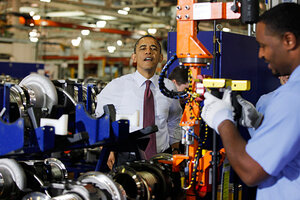How certain are you that robots won’t create as many jobs as they displace?
Robots and automation will not destroy the economy. How confident are we? Take our $2,500 challenge.

President Obama watches a worker during a visit to the heavy duty engines line at the Daimler Detroit Diesel plant in Redford, Mich., Dec. 10, 2012.
Charles Dharapak/AP/FILE
Watch out! Robots are coming for your jobs! Soon, there will be no more work for humans!
Or so say the techno-doomsayers.
From prominent economists such as Paul Krugman and Larry Summers to leading academics such as Massachusetts Institute of Technology’s Erik Brynjolfsson and Andrew McAfee, the prevailing view seems to be that the current wave of rapid technology innovation and widespread automation is unlike anything that has ever occurred before, and it is bound to destroy jobs for human workers faster than we can possibly create new ones.
The logical extension of this view is that we are headed toward a future in which a massive lumpenproletariat will presumably be on the government dole, a lucky few may be spared to work for table scraps, and an elite class of “robot” owners will get all the cake. With some predicting unemployment as high as 75 percent, a forlorn Mike Rettig of the Brookings Institution asks, “Will the last human worker please turn out the lights?”
But on behalf of the Information Technology and Innovation Foundation, I am willing to challenge the doomsayers. We say robots will boost productivity, lower prices, and increase wages. In so doing, they will increase demand throughout the economy, which will spur growth and, yes, create jobs.
Some occupations no doubt will see job losses because robots and other forms of technological automation will handle the work better than humans can. Policymakers certainly should do more to help people in those jobs. The obvious approach would be for Congress to revamp the federal program that now provides training and job-search assistance to workers who have been displaced by global trade, so it covers workers who are displaced by technological advances, too.
It would be economically disastrous, however, for policymakers to give into Luddite urges to throttle back on robotics, artificial intelligence, or other fields of potentially disruptive technology by redirecting federal research funds, imposing taxes, regulatory barriers, or any other means of staving off change to preserve the status quo for workers. We must recognize that technology innovation and productivity hold the keys, not to our undoing, but to higher living standards and a better quality of life.
The big picture is that technology innovation always has and always will drive growth. A century ago, mechanization eliminated a great deal of agricultural labor – but it also created many more new opportunities in other industries. Now, digitization is triggering upheaval and churn throughout the economy. But when industries apply these new technologies to boost productivity, it means they can increase wages or lower prices. This stimulates a virtuous cycle of increased spending throughout the economy, which drives new job creation – maybe not in the same industries as before, but in other occupations that spring up or expand as the economy grows to meet growing demand.
So while there may be losses in some industries, on net, there will be no fewer jobs in the economy than before. A modernized adjustment assistance program for workers who have been displaced by trade and technology can accelerate this transition for individuals and entire industries, further bolstering growth throughout the economy.
ITIF is so confident that these same economic principles will continue to hold true in the current wave of technological innovation, automation, and change that we hereby challenge the naysayers. We will give $2,500 to the first techno-doomsayer who accepts our challenge and can show that in 10 years, despite continued advances in automation, the US unemployment rate has become jarringly different than it is today.
For the purpose of this challenge, let me be specific about the economic terms: ITIF is certain that in the fourth quarter of 2025, the US unemployment rate, as determined by the Bureau of Labor Statistics, will continue to be lower than 8 percent (which is to say one-tenth of what some alarmists have been predicting). The only caveat in this prediction is that if the country happens to be in a cyclical recession, as determined by the National Bureau of Economic Research, then the reference quarter will be the first quarter before the beginning of that particular recession.
At the designated time, if the unemployment rate is 8 percent or higher, then ITIF will give you $2,500, no strings attached. If the unemployment rate is lower than 8 percent, then you should donate $2,500 to a charitable organization of ITIF’s choice.
Anyone in?
Robert D. Atkinson is president of the Information Technology and Innovation Foundation.

